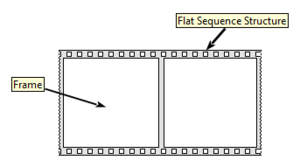Flat Sequence structure: Difference between revisions
Appearance
mNo edit summary |
|||
| (3 intermediate revisions by 2 users not shown) | |||
| Line 1: | Line 1: | ||
{{TOCright}} | |||
{{LabVIEW Palette Object Information|palette=Functions Palette/Programming/Structures{{!}}Structures palette|type=structure|icon=Functions Palette - Programming - Structures - Flat Sequence Structure.png}} | |||
[[File:Flat Sequence Structure - Components.png|thumb|Components of the Flat Sequence Structure]] | [[File:Flat Sequence Structure - Components.png|thumb|Components of the Flat Sequence Structure]] | ||
A Flat Sequence Structure is a primitive [[Functions Palette/Programming/Structures|structure]] that can have one or more [[Subdiagram|subdiagrams]] (also known as "Frames"), that are executed sequentially from left to right. | A '''Flat Sequence Structure''' is a primitive [[Functions Palette/Programming/Structures|structure]] that can have one or more [[Subdiagram|subdiagrams]] (also known as "Frames"), that are executed sequentially from left to right. | ||
== Usage == | |||
== Adding and removing frames == | === Adding and removing frames === | ||
Frames can be added and removed via the right-click menu: | Frames can be added and removed via the right-click menu: | ||
| Line 25: | Line 28: | ||
* Use the flow of data between nodes instead of flat sequence structures<ref>[https://forums.ni.com/t5/LabVIEW-News/Top-5-LabVIEW-Rookie-Mistakes/ba-p/3483109 LabVIEW News: Top 5 LabVIEW Rookie Mistakes]</ref> | * Use the flow of data between nodes instead of flat sequence structures<ref>[https://forums.ni.com/t5/LabVIEW-News/Top-5-LabVIEW-Rookie-Mistakes/ba-p/3483109 LabVIEW News: Top 5 LabVIEW Rookie Mistakes]</ref> | ||
* Use ''error in (no error)'' and ''error out'' terminals instead of flat sequence structures to enforce sequential execution of VIs. | * Use ''error in (no error)'' and ''error out'' terminals instead of flat sequence structures to enforce sequential execution of VIs. | ||
* In [[LabVIEW 2018]] and later, use [[ | * In [[LabVIEW 2018]] and later, use [[Stall Data Flow function|Stall Data Flow]] instead of a flat sequence structure to delay execution. | ||
== History == | |||
{{ambox|text=History information is needed. What changes have occurred over previous versions?}} | |||
{| class="wikitable" | |||
! Version | |||
! Change(s) | |||
|- | |||
|[[File:LV2018.png|frameless|border|64x64px|LabVIEW 2018|link=LabVIEW 2018]] | |||
|More info to come. | |||
|} | |||
== See also == | == See also == | ||
| Line 34: | Line 47: | ||
<references /> | <references /> | ||
[[Category:Structures]] | [[Category:Structures Palette]] | ||
[[Category:Flat Sequence Structure]] | [[Category:Flat Sequence Structure]] | ||
Latest revision as of 15:38, 25 June 2020
| Object information | |
|---|---|
| Owning palette(s) | Structures palette |
| Type | Structure |
| Requires | Basic Development Environment |
| Icon | |

A Flat Sequence Structure is a primitive structure that can have one or more subdiagrams (also known as "Frames"), that are executed sequentially from left to right.
Usage
Adding and removing frames
Frames can be added and removed via the right-click menu:
| Option | Description |
|---|---|
| Add Frame After | Adds a frame after the current frame |
| Add Frame Before | Adds a frame before the current frame |
| Delete This Frame | Deletes the current frame |
Best practice
- Use the flow of data between nodes instead of flat sequence structures[1]
- Use error in (no error) and error out terminals instead of flat sequence structures to enforce sequential execution of VIs.
- In LabVIEW 2018 and later, use Stall Data Flow instead of a flat sequence structure to delay execution.
History
| |
History information is needed. What changes have occurred over previous versions? |
| Version | Change(s) |
|---|---|

|
More info to come. |
